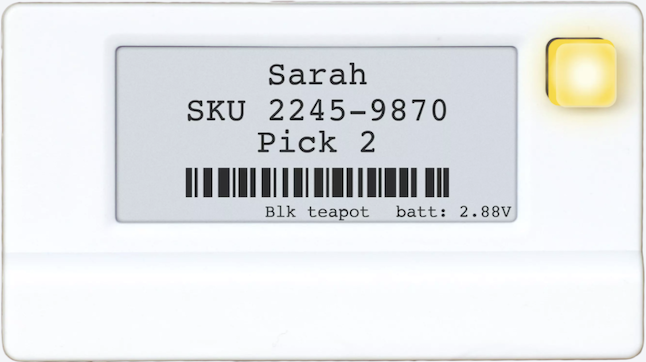Pick to Light Systems
Pick to light systems use displays and buttons in combination with warehouse storage. They give staff directions on where to pick the items from along with the quantity needed for a particular order.
In a typical system, an operator scans a barcode or enters a work order number, and the system retrieves the required bill of materials for the order while lighting up the various locations for picking the items. A display (either with an LCD screen, a small monitor, or even an eInk display) indicates the quantity of items to be picked, an LED on the unit will light up, and the worker can press a button on the unit after picking the parts. This will turn off the light and refreshing the display.
Multiple workers can be picking in the same warehouse simultaneously by changing the color of the lights on the displays to indicate which user needs to pick which parts from where. Be sure to read our article with the
Increased Efficiency
When using something like an eInk display or a monitor you can add information to the pick to light system to increase your worker’s efficiency. At the most basic level not having to search for a storage location for a part they aren’t familiar with will give you efficiency gains, but you can also be smart about routing them through an optimal path through the order to be picked.
At each location you could show the current part to be picked, quantity, etc. and on the bottom of the display indicate the next location to go to. With the work order you can pull in a list of what locations are required to complete the bill of materials, so you could easily set up a route to reduce the amount of walking or driving distance required to pick the parts in the optimal order.
If you want to manage First In First Out (FIFO) picking for storage locations containing perishable goods, or if you want an operator to pick particular lot numbers before others you can put this information on the display as well, indicating exactly which parts need to be picked at any location.
Reduce Training Time and Re-Picks
By empowering your workers with as much information as they need to pick any part at a given location you will reduce the amount of training time required to get your workers up to speed. They won’t need to memorize the location of all of the parts in your warehouse, and they won’t have to spend time searching for locations if something has moved since they last time they picked it.
You can even add in another layer of checks and balances if you want to have a complete picture of your picking operations by requiring the workers to scan parts as they are picked, validating against the FIFO and lot number requirements to give them a go or no go indication on the parts to be picked.
Technology Integration
With a pick to light system in place you can integrate with your warehouse management and SCADA systems to automate the order picking selection process.
If you have a production schedule in place you will know what work orders are coming down the line on any given day and can generate pick lists ahead of those work orders to ensure the warehouse staff can pick them and have the material on the line when it is needed to run production. You can easily track quantities of parts in any given location, telling the workers to pick the remaining X units from Location A, then move to Location B and grab the last Y units to complete the line item on the work order.
While some pick to light technology requires you to run electrical and network cabling out to the warehouse locations, there are many modern options where you can simply mount a battery powered controller in a small enclosure with a magnet with all of the hardware built-in, have it automatically connect to the brains of the pick to light system and even alert you when the devices need to be charged.
In Closing
Pick to light systems are a powerful tool in the manufacturing technology arsenal, and can be implemented with relatively low impact hardware at reasonable cost, giving you a very fast ROI through increased throughput and reduced excess travel time. It can even start to form the basis of an AGV integration if you are in a larger facility, using the backend of the pick to light system as an input point to the AGV system for routing those units in the warehouse.
Updated - 8/20/2022

